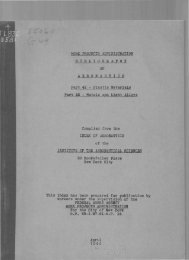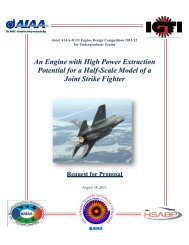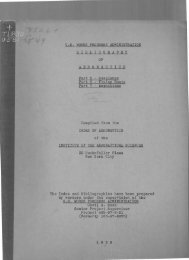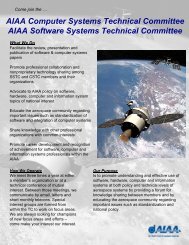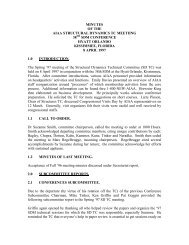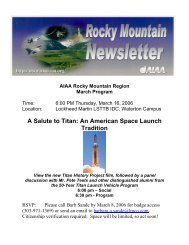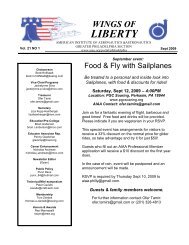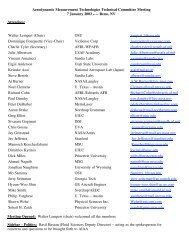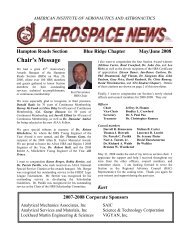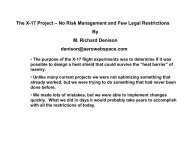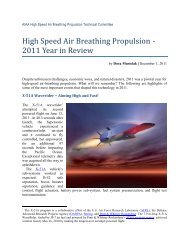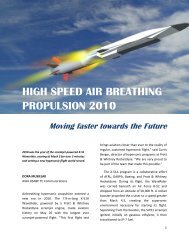Apollo-The Last Few Miles Home - AIAA Info
Apollo-The Last Few Miles Home - AIAA Info
Apollo-The Last Few Miles Home - AIAA Info
Create successful ePaper yourself
Turn your PDF publications into a flip-book with our unique Google optimized e-Paper software.
<strong>Apollo</strong>-<strong>The</strong> <strong>Last</strong> <strong>Few</strong> <strong>Miles</strong> <strong>Home</strong><br />
Charles H. Lowry<br />
May 19, 2012<br />
1
Jules Would Be Pleased<br />
3
Manned Spaceflight Timeline<br />
• 1865—Jules Verne “From <strong>The</strong> Earth To <strong>The</strong> Moon”<br />
• 1869—E. E. Hale “<strong>The</strong> Brick Moon”, Also Proposed “GPS”<br />
• 1897—H. G. Wells “War of <strong>The</strong> Worlds”<br />
• 1948—H. E. Ross, British Planetary Soc. Plan for Lunar Landing and Return<br />
• 1952—Von Braun “Man on <strong>The</strong> Moon, <strong>The</strong> Journey”<br />
• 1954—Von Braun “Can We Go To Mars?”<br />
• 1961—First Manned Mercury Flight<br />
• 1965-- First Manned Gemini Flight<br />
• 1968—First Manned <strong>Apollo</strong> Flight<br />
4
• A Look Around<br />
– $2000 Buys New Car<br />
– Cigarettes 25 Cents/Pack<br />
– Minimum Wage $1.00/Hr<br />
– $15/Night In Nice Hotel<br />
– Many Scientists Believed—to the Moon by end of<br />
Century<br />
• Engineering Profession<br />
– Pipes / Cigars / Starched Shirts / Jackets / Ties<br />
– 1 Secretary/1 Phone Per Group<br />
– No Repro Machines—later <strong>The</strong>rmofax<br />
– Slide Rules / Friden / Marchant Calculators<br />
– IBM 704—not for General use<br />
– 17x 22in /Felt Pen Briefing Charts<br />
– Hey-day Of Aircraft, Escape Systems<br />
• Parachute Profession<br />
– WADC Center Of Excellence<br />
– Dr. Heinrich, <strong>The</strong>o Knacke, Others<br />
– Lots of Basic Research<br />
– Nylon Ruled<br />
– 1956 Parachute Handbook<br />
– MIT, University of Minnesota Conferences<br />
– El Centro<br />
<strong>The</strong> Times--<strong>The</strong> 1950s/1960s<br />
First hp<br />
handheld/baz<br />
5
Space Race Progression<br />
• 57-58 International Geophysical Year—Sputnik/Explorer 1<br />
• July 58 NASA Created<br />
• Apr 61 Yuri Gagarin orbital Vostok 1<br />
• May 61 Alan Shepard sub-orbital Mercury<br />
• Jul 61 Initial NASA <strong>Apollo</strong> ITB<br />
• Nov 61 Announcement NAA Awarded <strong>Apollo</strong> CSM Contract<br />
• Dec 61 NASA SOW<br />
• Dec 61 Northrop Awarded ELS Contract<br />
• Feb 62 John Glenn Orbital Mercury<br />
• Jul 62 LOR Decision<br />
• Jul 62 1 st Main Chute Drop Test<br />
• Nov 62 1 st Main Chute cluster and 1 st Boilerplate Drop<br />
• Sep 63 Lost Boilerplate 3<br />
• Jan 67 <strong>Apollo</strong> 1 Fire<br />
• Oct 68 1 st Manned <strong>Apollo</strong> Flight<br />
• Dec 68 1 st Manned Circumlunar Flight<br />
• Jul 69 1 st Manned Lunar Landing<br />
6
Trip To <strong>The</strong> Moon<br />
• Getting Started<br />
– Contracts/subcontracts for all elements<br />
– Many support studies, universities, etc.<br />
– NASA guidance<br />
– Presidential DX priority<br />
– Money<br />
• Approach<br />
– Start running—figure it out as we go<br />
– Hire people—lots of people<br />
– Build facilities<br />
– Develop organizations<br />
– Develop specs, procedures, system architectures<br />
– Schedules, budgets<br />
– Go Do It<br />
• Reality<br />
– Much chaos—slowly settled<br />
– Many changes, weights, management directives/tools<br />
– Driven by what’s on pad<br />
7
<strong>Apollo</strong> VAB-Launch Complex<br />
8
• Use Existing Technology<br />
• Robust Designs<br />
• Try Alternate Designs<br />
• Extensive Acceptance Testing<br />
• Extensive Off-Limit Testing<br />
• Attention to Details<br />
• Control Changes<br />
• Analysis of Discrepancies<br />
• Personal Responsibility<br />
• Management Honesty<br />
• Customer Close to Us<br />
• Tangible Proof of System Integrity<br />
<strong>Apollo</strong> Hallmarks<br />
9
<strong>Apollo</strong> Stack<br />
10
CSM<br />
11
CM/Boilerplate Dimensions<br />
12
Max Rate of Descent-2 mains<br />
Orig—30fps at 5000ft<br />
Later—35fps at sea level<br />
Finally—38fps at sea level<br />
Performance Requirements<br />
Drogue and Main Chute<br />
Deployment Envelope<br />
Reliability<br />
Tolerate 1 Drogue/1 main out<br />
Goal--.99994<br />
CM Weight Growth<br />
History<br />
13
Early <strong>Apollo</strong> ELS Architecture<br />
14
ELS Configuration Evolution<br />
• Pre-block 1—started out<br />
– Boilerplates, 7,800-8,150 lbs.<br />
– Single 13.7 ft. drogue<br />
– 3 pilot chutes, 10 ft. diameter<br />
– 3 mains, 88.1 ft. diameter, 72 gore, 1.0 D O lines, single reefing<br />
– 4-leg harness attached to top of tunnel, textile risers, confluence fitting<br />
• Block 1<br />
– No docking provisions, 9,500 lbs., intended 1 st manned flight<br />
– 7.2 ft. diameter pilot chutes<br />
– Slotted mains, 83.5 ft. diameter, 68 gores, midgore reefing, 1.4 D O lines<br />
– 2-leg harness on deck<br />
– Dual drogues, reefed 8 seconds<br />
• Block 2<br />
– Docking provisions, redesigned forward compartment, 11,000 lbs.<br />
– Steel risers<br />
– Flowerpot<br />
• Block 2 HW<br />
– 13,000-13,500 lbs.<br />
– High density packing<br />
– Special materials<br />
– 2-stage main reefing, 6 & 10 seconds<br />
– Larger (16.5 ft.) drogues reefed 10 seconds<br />
– Beefed up pilots<br />
15
Normal Landing Sequence<br />
16
Abort Landing Sequence<br />
17
ELS Installation<br />
18
-Y Bay<br />
19
+Z Bay<br />
20
-Y to +Z Bays<br />
21
+Y Bay<br />
22
Flowerpot/Steel Risers (-Z Bay)<br />
23
Steel Cable Risers<br />
24
• 1 x 7.2ft Ringslot, perm reefed<br />
Forward Heatshield Jettison<br />
25
ELS Schematic<br />
27
6<br />
5<br />
4<br />
3<br />
2<br />
1<br />
0<br />
<strong>Apollo</strong> Component Environmental Acceptance Test Failure Rates<br />
Vibration ATP Percent Failure<br />
Design Workmanship Total<br />
12<br />
10<br />
8<br />
6<br />
4<br />
2<br />
0<br />
<strong>The</strong>rmal ATP Percent Failure<br />
Design Workmanship Total<br />
11447 tests on 166 different components 3685 tests on 127 different components
Mode Percent Failed<br />
Electrical<br />
Mechanical<br />
Contamination<br />
Other<br />
Total<br />
<strong>Apollo</strong> Component Failures<br />
57.3<br />
27.4<br />
11.6<br />
3.8<br />
100<br />
<strong>Apollo</strong> 7 22<br />
<strong>Apollo</strong> 8 8<br />
CSM LM<br />
<strong>Apollo</strong> 9 14 12<br />
<strong>Apollo</strong> 10 23 15<br />
<strong>Apollo</strong> 11 9 13<br />
Environmental ATP Failure Modes Number of <strong>Apollo</strong> Flight Anomalies
<strong>Apollo</strong> CM –to—LEM Docking<br />
30
<strong>Apollo</strong> Docking System<br />
31
<strong>Apollo</strong> Docking System Removal<br />
32
<strong>Apollo</strong> Soyuz Test Project<br />
33
ASTP Docking System--USA<br />
34
<strong>Apollo</strong> CM Uprighting System<br />
35
ELS Test Programs<br />
• Lab Tests<br />
– Humidity, thermal cycle, thermal vacuum, vib, accel, structural<br />
– Wind tunnel<br />
• 1/10 th scale drogues<br />
• Scaled and full size mains<br />
• Drop Tests<br />
– C-119, C-130, B-57, B-66, B-52, C-133<br />
– Mostly El Centro, CA,-joint test facility<br />
– Northrop ran tests with military<br />
• NAA / Rockwell, NASA participation<br />
– High visibility test program (July 1963 to July 1968)<br />
• Block 1, 93 dev, 12 qual (70 total planned)<br />
• Block 2, 6 dev, 4 qual<br />
• Block 2HW, 25 dev, 7 qual<br />
38
Instrumented Bomb Test Vehicle<br />
39
PTVs<br />
40
Boilerplate rigged for drop.<br />
Note external programmer chute<br />
Boilerplate Drop Equipment<br />
C-133 with boilerplate<br />
installed-ready to drop<br />
41
Programmer Parachute<br />
42
Boilerplate Drop Test<br />
43
• 6 WSMR Launches<br />
– Launch Escape System<br />
– All Abort Modes<br />
– 5 B/P, 1 CM, all Block 1<br />
• 4 KSC Block 1 CM Launches<br />
– Aero<br />
– Heatshield<br />
– RCS<br />
– G & N<br />
• 1 st Manned, Block 2<br />
– System Verification<br />
• 2 nd Manned<br />
– Circumlunar<br />
• 5 th Manned<br />
– Lunar Landing<br />
• 15 Total Manned Flights<br />
<strong>Apollo</strong> ELS Progression to Manned Flight<br />
44
• Chutes are different<br />
Chutes Are Harder<br />
• Chutes operate to a narrow set of precise rules<br />
– Except when they don’t<br />
• It’s mostly about deployment<br />
• Complex systems require Hi fidelity mock-up<br />
• Flight test lots and at higher levels of assembly<br />
• Program management doesn’t know or believe all this
• Vehicle Stability<br />
– Boilerplate 3<br />
– Steel Cables<br />
• Vehicle Weight Growth<br />
– Stowage Volume<br />
– High Density Packing<br />
– Vt=30fps @5kft to 38fps @ SL<br />
Big Problems Within ELS<br />
46
• Cluster Non-Uniformity<br />
– 3 Mains—40-30-30%<br />
– 2 mains—65-35%<br />
Big Problems Within ELS<br />
47
• Forward heat shield re-contact<br />
– Never understood wake<br />
– Added parachute<br />
• Block 1<br />
• Block 2<br />
Big Problems Within ELS<br />
48
• <strong>Apollo</strong> 15<br />
Big Problems Within ELS<br />
– Effects of Reaction Control System<br />
– Crew Technique<br />
49
Lessons Learned<br />
• Be wary of programs that think<br />
– Vehicle is stable<br />
– Weight will not increase and volume will not decrease<br />
– Wake is understood<br />
• Its mostly about deployment<br />
– Simplicity, neatness=reliability<br />
– Rounded corners/ no snags<br />
– HiFi mockups required<br />
– Installation training/closeout photos<br />
• How to live with steel risers<br />
• Drop tests—important but difficult<br />
– Need lots of tests to “wring out” system<br />
– Get to system level as soon as possible<br />
– Skipped stage/structural/attitude hard to do<br />
– Free-fall is dangerous<br />
– Must budget for significant retests & lost vehicles<br />
• More Ringsail development needed re lead/lag<br />
• Pilot riser dynamics<br />
• Better analytical tools needed<br />
• Many failures materials & processes<br />
• Intra-system influences can be serious<br />
50
What Makes Programs Successful?<br />
• <strong>Apollo</strong> 20,000 firms, 400,000 people—George Low says<br />
– Reliable hardware<br />
• Design<br />
• Test<br />
• Control of changes<br />
• Interpretation of discrepancies<br />
– Flt missions well planned and executed<br />
– Flt crews skilled and well trained<br />
• Also Emphasized<br />
– Attention to detail<br />
– Dedication to getting the job done<br />
51
What About the SR-71----How Did <strong>The</strong>y Do It?<br />
• Urgent National Need<br />
• Visionary Government and Industry<br />
• Willingness to Take Risks<br />
• Tolerance for Failure<br />
• Minimum People and Paperwork<br />
• Individual Responsibility<br />
• Cradle to Grave Ownership of Design<br />
Skunk Works, Ben Rich, 1994<br />
• Started Work 1959<br />
• Mach 3, 90,000 ft. alt<br />
52
Looking Back On <strong>Apollo</strong><br />
• National goal & priority<br />
• Excellent, experienced management & technical<br />
• Work ethic<br />
• Attention to detail<br />
• Block 2 was a God-send, Block 2HW was not<br />
• Lots of testing including pre-qual<br />
• Always driven by something on pad<br />
• Need tolerance for failure<br />
• Wish we would have had Kevlar<br />
• Intra-sys effects<br />
• Worry a lot<br />
53
Interesting Experiences / Failures<br />
• Contamination<br />
• Metallurgical problems<br />
• Human failures<br />
• Lack of robustness<br />
• Exterior influences<br />
54



